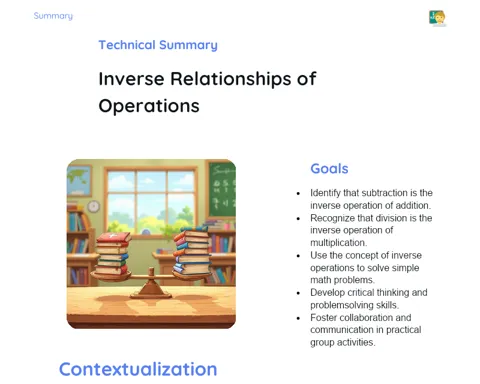Area and Perimeter: Comparison | Active Summary
Objectives
1. 🔍 Explore Area and Perimeter Measurements: Learn to calculate and compare areas and perimeters of geometric figures such as squares, rectangles, and triangles.
2. 🛠️ Apply Concepts in Practice: Use these measurements in real and hypothetical situations to solve problems and make decisions.
3. 🤔 Develop Critical Thinking: Analyze and compare figures with different areas and perimeters, understanding their implications and practical applications.
Contextualization
Did you know that the ability to calculate areas and perimeters is fundamental in various professions and everyday tasks? Architects use these concepts to design houses and buildings, farmers to plan their land's planting, and even decorators to estimate the amount of material needed to cover walls or floors. These skills are not just mathematical; they are incredibly practical and applicable in many real situations!
Important Topics
Area of Geometric Figures
The area is the measure of a two-dimensional surface, such as the space inside a rectangle, triangle, or square. To calculate the area, we multiply the length by the width (or base by height, depending on the shape of the figure). For example, the area of a rectangle with sides of 4 units and 6 units would be 24 square units.
-
Formulas: The formulas for calculating the area vary depending on the shape of the figure. For example, the area of a square is side * side, while the area of a triangle is 0.5 * base * height.
-
Units of Measurement: Areas are often expressed in square meters (m²) or square centimeters (cm²), depending on the scale of the figure.
-
Practical Applications: Understanding area is crucial for tasks such as calculating the amount of paint needed to paint a wall or the space required to install a floor.
Perimeter of Geometric Figures
The perimeter is the measure of the contour of a figure, that is, the sum of all its sides. For example, the perimeter of a rectangle with sides of 4 units and 6 units would be 20 units. Calculating the perimeter is vital for planning fences, paths, or any situation where measuring the contour is important.
-
Formulas: The perimeter formulas are simple additions of the sides. For a square, for example, it is 4 times the side.
-
Units of Measurement: The perimeter is measured in the same units as the sides of the figure, such as meters or centimeters.
-
Practical Applications: Important for garden design, road construction, and many other engineering and design applications.
Comparison of Areas and Perimeters
Understanding that figures with the same perimeter can have different areas and vice versa is fundamental. This is due to the various possible combinations of side lengths in geometric shapes that maintain the same perimeter but have varied areas. For example, a rectangle with sides 2 and 8 has the same perimeter as a square with side 5, but their areas are different.
-
Logical Reasoning: Develop logical reasoning skills by analyzing how changing the dimensions of a figure affects its area and perimeter.
-
Applications in Engineering: Important in optimizing material use, such as choosing shapes for structures that maximize surface area with minimal material.
-
Mathematical Challenges: Figures with equal areas and different perimeters or vice versa offer interesting mathematical challenges to solve.
Key Terms
-
Area: The measure of a two-dimensional surface within a figure.
-
Perimeter: The sum of all sides of a figure.
-
Units of Measurement: Standardized methods for expressing measurements, such as square meters (m²) and centimeters (cm).
-
Formulas: Mathematical expressions used to calculate the area and perimeter of different geometric figures.
To Reflect
-
How does changing the dimensions of a figure affect its area and perimeter? Provide real or hypothetical examples.
-
Why is it important to understand the difference between area and perimeter in practical situations like design and construction?
-
In what ways can knowledge of areas and perimeters help solve everyday challenges?
Important Conclusions
-
Today, we explored the fascinating world of area and perimeter of geometric figures, learning to calculate and compare these measurements in different contexts.
-
We discovered that figures with the same perimeter can have very different areas, and vice versa, which is crucial for many practical applications like park design and space optimization.
-
We reinforced the importance of these concepts not only as mathematical tools but as essential skills in daily life and in various professions and everyday situations.
To Exercise Knowledge
- Create Your Ideal Park: Using graph paper, draw the layout of a park that includes a lake, a recreation area, and paths. Calculate the total area of the park and each component. 2. Equal Perimeter Challenge: Draw three different figures that have the same perimeter but different areas. Calculate and compare their areas. 3. Planning with Perimeter: Imagine you have a piece of fabric with a fixed perimeter. Draw different shapes that this fabric could take, calculating the area each shape would cover.
Challenge
🌟 Junior Architect Challenge: You are the architect of a new city park! With a fixed perimeter provided, design a park that maximizes the area of each component (lake, playground, gardens) while maintaining aesthetic and functional balance. Present your design with calculations and design rationales.
Study Tips
-
Use drawings and real figures to practice calculating area and perimeter, making learning more visual and tangible.
-
Create flashcards with formulas and examples of area and perimeter calculations for regular review and reinforcement of memorization.
-
Discuss with friends or family how areas and perimeters are used in everyday situations, such as in interior decoration or garden planning, to see math in action.



